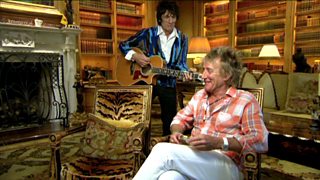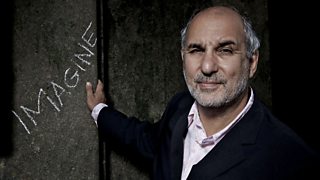Behind the scenes of Rod Stewart - Can't Stop Me Now
Researcher Lorna Lithgow talks about her experience making the programme, and why Rod and the rest of Faces once pretended to be Fleetwood Mac.
The name Rod Stewart conjures up many things in people's minds. Football? Check. Tartan? Definitely. Leopard print leggings? True, but let's never speak of that again. What unfairly gets overlooked is the music. Considering his peerless early 70s albums (any good record collection needs Every Picture Tells A Story), that wistful, whisky-soaked voice, or the string of self-penned classics - from the achingly gorgeous Mandolin Wind to the joyous swagger of Stay With Me; Rod‘s officially underrated. And that's without even mentioning his stints as lead singer with The Jeff Beck Group and Faces, both hugely influential acts that shaped British music.
With Rod's recent best-selling autobiography and a number one album, this seemed like the ideal time for imagine… to reappraise the Stewart oeuvre. And so it was that we embarked upon our odyssey, or rather Rodyssey, to explore his extraordinary life and musical legacy.
Whether it was the euphoric footage of the Faces' boozy onstage performances or early 80s videos of Rod bopping, poolside, in a dubious pants-and-visor combo, there was a wealth of archival treasures to delve into. The most exciting find was a 1965 documentary detailing the weekend in the life of a 20-year-old Rod just embarking on his musical career. Lying in bits and pieces on the BFI shelves, the film, once assembled, proved to be a remarkable visual document of 60s London, showing Rod belting out Muddy Waters numbers in the Marquee Club, chatting up girls in the Manor House pub and, er, simply going to the post office.
When we travelled to interview Rod in LA, we presented him with the film. Viewing this footage for the very first time, Rod was visibly emotional, watching himself as a young man finding his feet in life and seeing his much missed Mum and Dad interviewed in their sweet shop on the Archway Road in London where he grew up.
Another filming highlight was interviewing Rod at his LA home with friend and musical foil, Ronnie Wood. It looked a close run thing on arrival - with the security gates failing to open, Ron leapt out of his car and attempted to scramble over them. To everyone's relief, we were swiftly granted entry, avoiding potential broken bones and the cancellation of a Stones tour, and Ron bounded into Rod's house clutching a guitar and serenading his old pal with a folk song. Scripted questions were soon abandoned as they embarked on a double-act, reminiscing about the early days - bonding over their similar haircuts the first time they met, being so badly paid by band management they had to resort to shoplifting eggs and the Faces’ infamous hotel parties which saw them barred from the Holiday Inn chain but beating the ban by checking themselves in as Fleetwood Mac.
Contrary to the stories of Rod as playboy and partier, we witnessed him during our shoot as a family man at heart who likes nothing better than playing football with his two Celtic-mad youngest sons on his private football pitch. And nowadays his abiding passion is less fast cars and more model railways ("Don’t call it a train set!" he instructed us, when he talked about his hobby).
And bringing the focus back to music, we were lucky enough to see Rod on stage when he played an intimate show at the legendary Troubadour Club. It was inspiring to watch him sing - half a century on - with a vigour and passion that easily matched his performance in that 1965 documentary. This past year has opened up a new chapter in Rod’s musical career and, even at 68, he looks unstoppable.
-
![]()
Watch Rod and Ronnie sing Worried Man Blues
-
![]()
The art series edited and presented by Alan Yentob
-
![]()
Watch The Rod Stewart Group filmed in London in 1976



